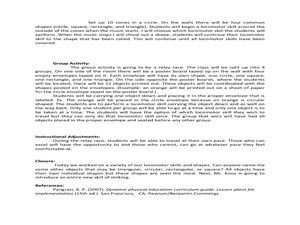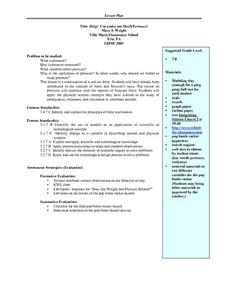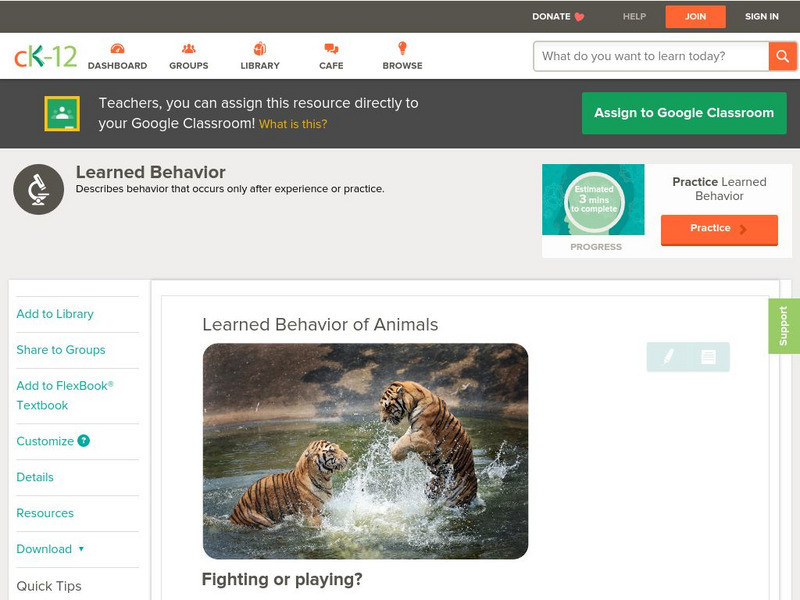Curated OER
Birds of Wisconsin
First graders explore the job done by ornithologists. They role play identifying the characteristics that make a bird a bird. They discuss what makes each bird species unique. Students are introduced to Wisconsin's most common and rare...
Curated OER
Laws of the Jungle
Students build a video game on predator-prey relationship. In this biology lesson, students identify the variables that affect this relationship. They write a short description and play each other's game.
Curated OER
This Place is Going to the Dogs
Students study different breeds of dogs. They watch a video, "Extraordinary Dogs", about special dogs and how they are categorized according to their adaptations. Then they create a digital video that demonstrates the qualities of dogs...
Curated OER
Investigation 10 - Mammal Oral Reports
Fourth graders research a Utah mammal, then create and present a mini-report. They access websites imbedded in this plan to help them with their research. There is also a nice prewrite graphic organizer to help them organize their...
Curated OER
Aquatic Insects: Water Quality Index & Diversity Index
Students search stream beds to study the life cycle and adaptations of stream insects. They explore creeks and streams to see the diversity index of creeks or streams and to find the water qualit index.
Curated OER
Word Books
Young scholars explore art and writing. They create a word book consisting of new words that they come across in their reading or words they hear from people. Students create a cover for their word books.
Curated OER
Habitat Unit - Day 2
Learners explore abiotic factors that affect habitats. After a class lecture, students work in groups to answer questions about plant tissue, production and growth. They share answers, complete a crossword puzzle, and create a habitat...
Curated OER
Ambush Warriors
Middle schoolers identify four different categories of reptiles and explain how snakes deliver their venom to their prey.
Curated OER
Time, Tide, and Quahogs
Students read tide tables for Waquoit Bay as the simulate determining the best time to go clam digging for a Wampanoag clambake. They graph the tide tables while realizing that the tides a Waquoit Bay are one hour later than those at...
Curated OER
Make a Cast of a Tyrannosaurus rex Fossil
Second graders examine the formation of fossils and list the different types. They make cast model of a dinosaur fossil. They write about conditions that are necessary for fossils to form and create a model of a buried fossil.
Curated OER
Safety Safari Poster
Students study the safety hazard list and discuss how students can make good choices in order to be safe and how they can choose between their personal feelings and keeping themselves safe. They brainstorm to make a list of safety...
Curated OER
Shapes and Review of Locomotor Skills
Students engage in a series of loco-motor activities based on shapes. In this loco-motor instructional activity, students demonstrate physical skills through races, jumping, hopping, galloping in circles, squares, rectangles and triangles.
Curated OER
On the Trail with Lewis and Clark
Eighth graders use the Internet to conduct research on the Lewis and Clark journals and work cooperatively in planning and delivering a presentation.
Curated OER
Turtle Sightings
Third graders research turtles and the ways they have adapted to their marine environment. They work in groups and publish their findings using SiteMaker a web-authoring tool.
Curated OER
Presto Change-o: Caterpillars to Butterflies
Students use the Internet to explore the four stages of a butterfly's life cycle. They make a model of a butterfly using macaroni, sticks and leaves.
Curated OER
Ancient History
Students investigate the concept of water usage and conservation. The differences between modern and ancient practices are considered. They conduct research into the economic and social characteristics of ancient civilizations like Egypt...
Curated OER
Help! I'm Under Too Much Pressure!
Pupils play with a ping pong ball sized piece of modeling clay observing what happens to the clay as they play with it and write their observations in their notebooks. They share the results of their observations introducing the term...
Curated OER
It's Alive! Or is it?
Students differentiate the characteristics of living and nonliving things. In this life science lesson, students compare and contrast robots and living things. Given an object, they decide whether it's is living or not and defend their...
CK-12 Foundation
Ck 12: Fourth Grade Science: Life Science: Learned Behavior of Animals
[Free Registration/Login may be required to access all resource tools.] Introduces learned behaviors and the different methods of learning.
Trinity University
Trinity University: Inherited Traits Versus Learned Behaviors [4Th Grade]
In this extremely detailed unit, students will learn the about innate and learned characteristics in animals and humans through a series of teacher and student-led discussions, readings, reflections, learning activities, and...
CK-12 Foundation
Ck 12: Life Science: Learned Behavior of Animals
[Free Registration/Login may be required to access all resource tools.] Just about all human behaviors are learned. Learned behavior is behavior that occurs only after experience or practice. Learned behavior has an advantage over innate...
CK-12 Foundation
Ck 12: Life Science: 8.3 Learned Behavior
Understand different types of learned behavior among animals and humans.
CK-12 Foundation
Ck 12: Biology: Learned Behavior of Animals
[Free Registration/Login may be required to access all resource tools.] Describes types of behavior that animals can learn.
McGraw Hill
Glencoe Biology: Basic Behaviors: Self Check Quiz
Try these five multiple-choice questions about the difference between innate and learned behaviors in animals. The quiz is self-checking, and provides hints to the student if needed.























